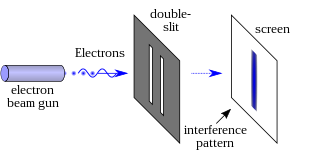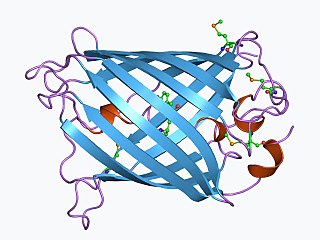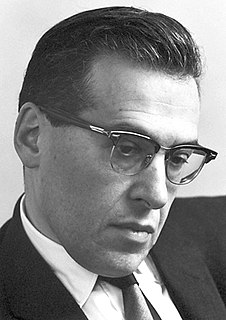
The alpha helix (α-helix) is a common motif in the secondary structure of proteins and is a right hand-helix conformation in which every backbone N−H group hydrogen bonds to the backbone C=O group of the amino acid located three or four residues earlier along the protein sequence.

In modern physics, the double-slit experiment is a demonstration that light and matter can display characteristics of both classically defined waves and particles; moreover, it displays the fundamentally probabilistic nature of quantum mechanical phenomena. This type of experiment was first performed, using light, by Thomas Young in 1801, as a demonstration of the wave behavior of light. At that time it was thought that light consisted of either waves or particles. With the beginning of modern physics, about a hundred years later, it was realized that light could in fact show behavior characteristic of both waves and particles. In 1927, Davisson and Germer demonstrated that electrons show the same behavior, which was later extended to atoms and molecules. Thomas Young's experiment with light was part of classical physics well before quantum mechanics, and the concept of wave-particle duality. He believed it demonstrated that the wave theory of light was correct, and his experiment is sometimes referred to as Young's experiment or Young's slits.

In quantum mechanics, Schrödinger's cat is a thought experiment that illustrates an apparent paradox of quantum superposition. In the thought experiment, a hypothetical cat may be considered simultaneously both alive and dead as a result of being linked to a random subatomic event that may or may not occur.
Wave–particle duality is the concept in quantum mechanics that every particle or quantum entity may be described as either a particle or a wave. It expresses the inability of the classical concepts "particle" or "wave" to fully describe the behaviour of quantum-scale objects. As Albert Einstein wrote:
It seems as though we must use sometimes the one theory and sometimes the other, while at times we may use either. We are faced with a new kind of difficulty. We have two contradictory pictures of reality; separately neither of them fully explains the phenomena of light, but together they do.

Edward Witten is an American mathematical and theoretical physicist. He is currently the Charles Simonyi Professor in the School of Natural Sciences at the Institute for Advanced Study. Witten is a researcher in string theory, quantum gravity, supersymmetric quantum field theories, and other areas of mathematical physics. In addition to his contributions to physics, Witten's work has significantly impacted pure mathematics. In 1990, he became the first physicist to be awarded a Fields Medal by the International Mathematical Union, awarded for his 1981 proof of the positive energy theorem in general relativity. He is considered to be the practical founder of M-theory.
Eternalism is a philosophical approach to the ontological nature of time, which takes the view that all existence in time is equally real, as opposed to presentism or the growing block universe theory of time, in which at least the future is not the same as any other time. Some forms of eternalism give time a similar ontology to that of space, as a dimension, with different times being as real as different places, and future events are "already there" in the same sense other places are already there, and that there is no objective flow of time.

The green fluorescent protein (GFP) is a protein that exhibits bright green fluorescence when exposed to light in the blue to ultraviolet range. The label GFP traditionally refers to the protein first isolated from the jellyfish Aequorea victoria and is sometimes called avGFP. However, GFPs have been found in other organisms such as copepods and lancelets.

In the physical sciences, subatomic particles are smaller than atoms. They can be composite particles, such as the neutron and proton; or elementary particles, which according to the standard model are not made of other particles. Particle physics and nuclear physics study these particles and how they interact. The concept of a subatomic particle was refined when experiments showed that light could behave like a stream of particles as well as exhibiting wave-like properties. This led to the concept of wave–particle duality to reflect that quantum-scale particles behave like both particles and waves. Another concept, the uncertainty principle, states that some of their properties taken together, such as their simultaneous position and momentum, cannot be measured exactly. The wave–particle duality has been shown to apply not only to photons but to more massive particles as well.
Matter waves are a central part of the theory of quantum mechanics, being an example of wave–particle duality. All matter exhibits wave-like behavior. For example, a beam of electrons can be diffracted just like a beam of light or a water wave. In most cases, however, the wavelength is too small to have a practical impact on day-to-day activities. Hence in our day-to-day lives with objects the size of tennis balls and people, matter waves are not relevant.

Julian Seymour Schwinger was a Nobel Prize winning American theoretical physicist. He is best known for his work on quantum electrodynamics (QED), in particular for developing a relativistically invariant perturbation theory, and for renormalizing QED to one loop order. Schwinger was a physics professor at several universities.

In condensed matter physics, a supersolid is a spatially ordered material with superfluid properties. In the case of helium-4, it has been conjectured since the 1960s that it might be possible to create a supersolid. Starting from 2017, a definitive proof for the existence of this state was provided by several experiments using atomic Bose-Einstein condensates. The general conditions required for supersolidity to emerge in a certain substance are a topic of ongoing research.

In philosophy of mind, panpsychism is the view that mind or a mindlike aspect is a fundamental and ubiquitous feature of reality. It is also described as a theory that "the mind is a fundamental feature of the world which exists throughout the universe." It is one of the oldest philosophical theories, and has been ascribed to philosophers including Thales, Plato, Spinoza, Leibniz, William James, Alfred North Whitehead, Bertrand Russell, and Galen Strawson. In the 19th century, panpsychism was the default philosophy of mind in Western thought, but it saw a decline in the mid-20th century with the rise of logical positivism. Recent interest in the hard problem of consciousness has revived interest in panpsychism.

Anton Zeilinger is an Austrian quantum physicist who in 2008 received the Inaugural Isaac Newton Medal of the Institute of Physics (UK) for "his pioneering conceptual and experimental contributions to the foundations of quantum physics, which have become the cornerstone for the rapidly-evolving field of quantum information". Zeilinger is professor of physics at the University of Vienna and Senior Scientist at the Institute for Quantum Optics and Quantum Information IQOQI at the Austrian Academy of Sciences. Most of his research concerns the fundamental aspects and applications of quantum entanglement.
The Afshar experiment is a variation of the double slit experiment in quantum mechanics, devised and carried out by Shahriar Afshar while at the private, Boston-based Institute for Radiation-Induced Mass Studies (IRIMS). The results were presented at a Harvard seminar in March 2004. Afshar claimed that the experiment gives information about which of two paths a photon takes through the apparatus while simultaneously allowing interference between the two paths to be observed, by showing that a grid of wires, placed at the nodes of the interference pattern, does not alter the beams. Afshar claimed that the experiment violates the principle of complementarity of quantum mechanics, which states roughly that the particle and wave aspects of quantum objects cannot be observed at the same time, and specifically the Englert–Greenberger duality relation. The experiment has been repeated by a number of investigators but its interpretation is controversial and there are several theories that explain the effect without violating complementarity.
In physics, complementarity is both a theoretical and an experimental result of quantum mechanics, also referred to as principle of complementarity. Formulated by Niels Bohr, a leading founder of quantum mechanics, the complementarity principle holds that objects have certain pairs of complementary properties which cannot all be observed or measured simultaneously.

In chemistry, the history of molecular theory traces the origins of the concept or idea of the existence of strong chemical bonds between two or more atoms.

Friday Harbor Laboratories (FHL), is a marine biology field station of the University of Washington, located in Friday Harbor, San Juan Island, Washington, United States. Friday Harbor Labs is known for its intensive summer classes offered to competitive graduate students from around the world in fields of marine biology and other marine sciences.

Julian Voss-Andreae is a German sculptor living and working in the U.S.

Angel of the West is an outdoor sculpture in Jupiter, Florida, United States. The sculpture was made in 2008 by German sculptor Julian Voss-Andreae. Referencing British sculptor Antony Gormley's monumental 1998 piece Angel of the North it was created based on an antibody structure published by E. Padlan for the Florida campus of the Scripps Research Institute. The antibody is placed into a ring referencing Leonardo da Vinci's Vitruvian Man highlighting the similar proportions of the antibody and the human body.
In quantum mechanics, fractionalization is the phenomenon whereby the quasiparticles of a system cannot be constructed as combinations of its elementary constituents. One of the earliest and most prominent examples is the fractional quantum Hall effect, where the constituent particles are electrons but the quasiparticles carry fractions of the electron charge. Fractionalization can be understood as deconfinement of quasiparticles that together are viewed as comprising the elementary constituents. In the case of spin–charge separation, for example, the electron can be viewed as a bound state of a 'spinon' and a 'chargon', which under certain conditions can become free to move separately.













